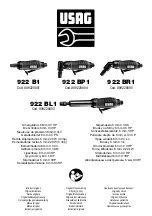
9
ENGLISH
(Original instructions)
u
Apply minimum pressure to the work surface, allowing the
tool to operate at high speed. Grinding rate is greatest
when the tool operates at high speed.
u
Position yourself so that the openunderside of the wheel is
facing away from you.
u
Once a cut is begun and a notch is established in the
workpiece, do not change the angle of the cut. Changing
the angle will cause the wheel to bend and may cause
wheel breakage. Edge grinding wheels are not designed
to withstand side pressures caused by bending.
u
Remove the tool from the work surface before turning the
tool off. Allow the tool to stop rotating before laying it
down.
Warning!
Do not use edge grinding/cutting wheels for surface
grinding applications if the wheel label has forbidden such use
because these wheels are not designed for side
pressures encountered with surface grinding. Wheel breakage
and serious personal injury may result.
Fitting and removing sanding discs (fig. D & E)
For sanding, a backing pad is required. The backing pad is
available from your Stanley Fat Max dealer as
an accessory.
Fitting
u
Place the inner flange (9) onto the spindle (4) as shown
(fig. E). Make sure that the flange is correctly located on
the flat sides of the spindle.
u
Place the backing pad (14) onto the spindle.
u
Place the sanding disc (15) onto the backing pad.
u
Place the outer flange (12) onto the spindle with the raised
centre facing away from the disc.
u
Keep the spindle lock (2) depressed and tighten the outer
flange using the two-pin spanner (13) (fig. D).
Make sure that the outer flange is fitted correctly and that
the disc is clamped tightly.
Removing
u
Keep the spindle lock (2) depressed and loosen the outer
flange (12) using the two-pin spanner (13) (fig. D).
u
Remove the outer flange (12), the sanding disc (15) and
the backing pad (14).
Surface finishing with sanding discs
u
Allow the tool to reach full speed before touching the tool
to the work surface.
u
Apply minimum pressure to work surface, allowing the tool
to operate at high speed. Sanding rate is greatest when
the tool operates at high speed.
u
Maintain a 5˚ to 10˚ angle between the tool and work
surface as shown in figure G.
u
Continuously move the tool in a forward and back motion
to avoid creating gouges in the work surface.
u
Remove the tool from work surface before turning tool off.
Allow the tool to stop rotating before laying it down.
Using sanding backing pads
Always choose the proper grit sanding discs for your
application. Sanding discs are available in various grits.
Coarse grits yield faster material removal rates and a rougher
finish. Finer grits yield slower material removal and a
smoother finish. Begin with coarse grit discs for fast, rough
material removal. Move to a medium grit paper and finish with
a fine grit disc for optimal finish.
u
Coarse = 16 - 30 grit.
u
Medium = 36 - 80 grit.
u
Fine Finishing = 100 - 120 grit.
u
Very Fine Finishing = 150 - 180 grit.
u
Allow the tool to reach full speed before touching tool to
the work surface.
u
Apply minimum pressure to work surface, allowing the tool
to operate at high speed. Sanding rate is greatest
when the tool operates at high speed.
u
Maintain a 5˚ to 10˚ angle between the tool and work
surface as shown in figure H. The sanding disc should
contact approximately 25mm of work surface.
u
Move the tool constantly in a straight line to prevent
burning and swirling of work surface. Allowing the tool to
rest on the work surface without moving, or moving the
tool in a circular motion causes burning and swirling marks
on the work surface.
u
Remove the tool from work surface before turning tool off.
Allow the tool to stop rotating before laying it down.
Precautions to take when sanding paint
u
Sanding of lead based paint is
NOT RECOMMENDED
due to the difficulty of controlling the contaminated dust.
The greatest danger of lead poisoning is to children and
pregnant women.
u
Since it is difficult to identify whether or not a paint
contains lead without a chemical analysis, we recommend
the following precautions when sanding any paint:
u
No children or pregnant women should enter the work
area where the paint sanding is being done until all
clean up is completed.
u
A dust mask or respirator should be worn by all persons
entering the work area. The filter should be replaced
daily or whenever the wearer has difficulty breathing.
Note:
Only those dust masks suitable for working with lead
paint dust and fumes should be used. Ordinary painting
masks do not offer this protection. See your local hardware
dealer for the proper approved mask.


































